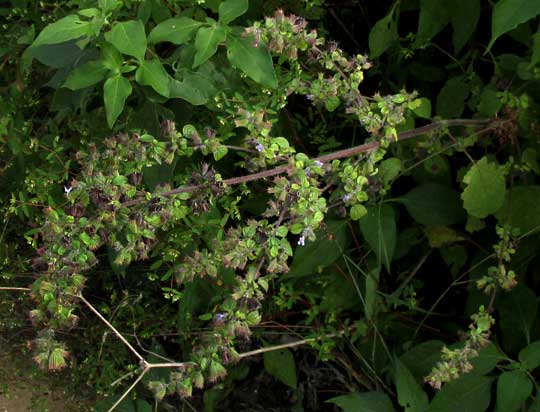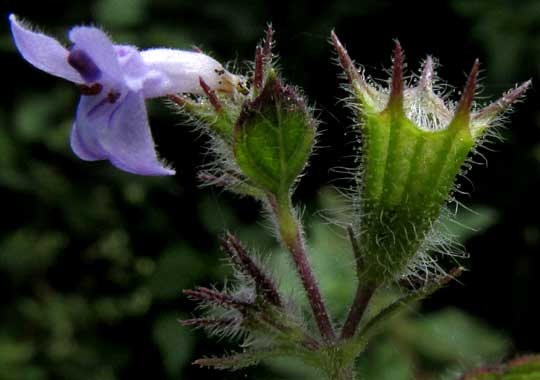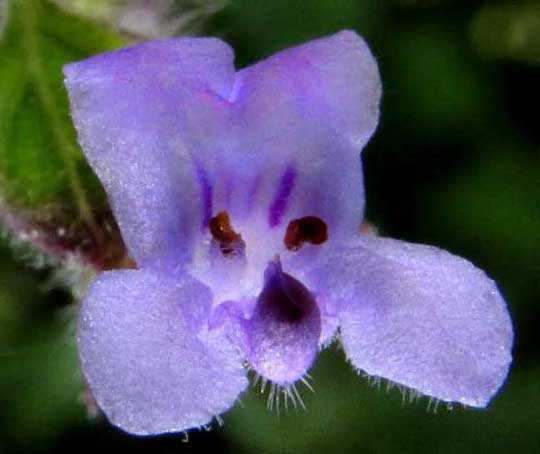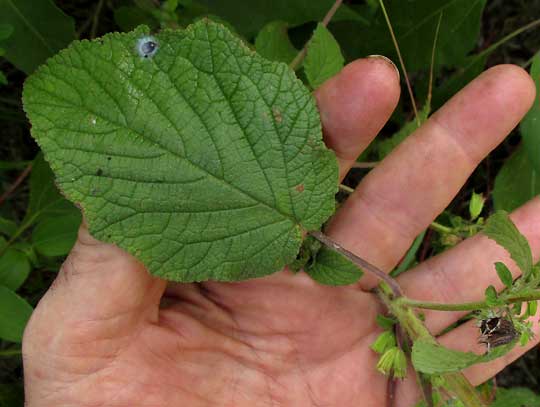Excerpts from Jim Conrad's
Naturalist Newsletter
from the December 13, 2015 Newsletter issued from Hacienda Chichen Resort beside Chichén Itzá Ruins, central Yucatán, MÉXICO
BUSHMINT
The little one-lane gravel road to a garbage dump near the hotel zone was hemmed in with head-high weeds and bushes that were as dense and shadowy-green as the late rainy season in the tropics can make it. Jutting from the wall was the peculiar-looking plant shown below:
 .
.
It was the fruiting and flowering, panicle-type head of some kind of robust-, disheveled- and aggressive-looking herb. Up close, its flowers were surprisingly small and delicate looking, as shown below:

In that picture notice that the calyxes' long hairs are interspersed with shorter, gland-tipped hairs. The gland-tipped hairs give the herbage a sticky feeling and must contain fragrant oils that contribute to the herbage's powerful odor. Northerners knowing their local wildflowers and garden herbs will recognize the smell and appearance of the flowers as typical of the Mint Family, the Lamiaceae. A view into the corolla confirming Mint Family features is shown below:

Mint Family features seen here include the bilaterally symmetrical corolla -- cut it down the middle from top to bottom and each side presents a mirror image of the other -- and the two stamens. Most kinds of mints bear four stamens but a small group, including this one, bears only two. Note the dark purple nectar-guides orienting pollinators toward the flower's bottom, where nectar is produced. The plant's leaves almost seem too large and leathery to belong to a mint, but that's the way these are, as shown below:

Our big herb is HYPTIS SUAVEOLENS*, thought to be native to the tropical Americas from Mexico and the Caribbean south into South America, plus it's invasive in most other tropical countries worldwide. Being so attention-getting and widespread, it bears many English names, including Bushmint and Pignut. In Mexico it's often known as Chan.
Bushmint's odor is not one of those sweet-spicy fragrances the Mint Family is famous for, but rather it's minty with strong undertones of a musky-oily kind. When you smell it, for the first half second you really like it, but then the odor grows heavy and musky, and eventually almost nauseating. Such potently smelling herbs often turn out to have medicinal value, and that's the case with Bushmint.
The online Atlas de las Plantas de la Medicina Tradicional Mexicana says that in the Sixteenth Century Bushmint's seeds, ground raw and eaten, were used against diarrhea. Those who coughed and spit blood took the ground root. Even still, in Mexico country people treat diarrhea with it, in some parts taking a tea of the roots while fasting, while in the Yucatán a tea is brewed from the leaves.
Lab tests confirm that the plant's essential oils are antibiotic, so there may be something to Bushmint's uses against bacteria-caused diseases.
A 2014 research paper out of India dealing with Bushmint, by Hitendra Padalia and others, describes it as "... rapidly invading tropical ecosystems across the world, including India, and is major threat to native biodiversity, ecosystems and livelihoods."
I've only seen this one plant around here, though.